IN THIS ISSUE
- DNR bat detectives
- Spring Creek surprise
- The (poor) state of birds
- When hummers are hunted
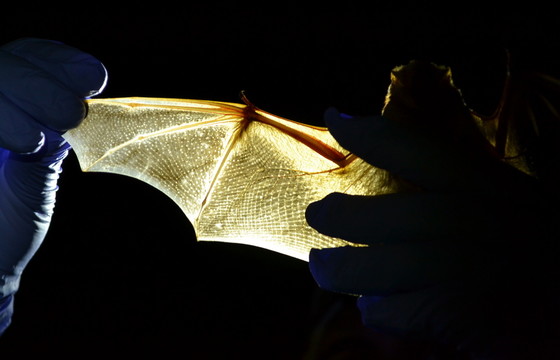 DNR staff examine the wing of a bat caught by mist-net. (Ethan Hatchett/DNR)
By Ethan Hatchett
As the sun sets on a summer day in Macon, Georgia DNR’s bat detectives go to work.
Wildlife technician Rachel Pack attaches a microphone to the roof of an agency truck. At nightfall, she begins slowly driving a preset route through neighborhoods in the middle Georgia city and along county roads just outside of it.
The rooftop microphone is part of the Anabat, a device that records bat calls. A speaker inside the truck cab emits sporadic beeps and screeches as the Anabat translates into human-friendly wavelengths the high-frequency sounds made by bats flying above. In a process called echolocation, the small mammals use sound to navigate and find prey in the dark.
Weeks later, Pack joins other DNR staff and a University of Georgia graduate student to set up tall, badminton-like nets on the Oconee National Forest near Greensboro. Once done, they again wait for it to get dark.
It’s another summer night shift for Pack. But they’re all focused on one thing: monitoring bats. …
Learn how DNR is tracking bat trends, and why, in this blog post.
UP NEXT: CULVERTS CHECKS
While summer is over, the detective work continues. In winter, biologists monitor bat populations in caves and culverts, while also documenting the status of white-nose syndrome, a disease fatal to bats. Caves are checked every other year to lessen the risk of disturbance. This winter, the agency will concentrate on culverts that double as significant bat roosts and check for white-nose and the fungus that causes it (Pseudogymnoascus destructans) in the southern part of the state.
 Spring Creek gator (Matthew Rowe/DNR)
This scare didn’t go bump in the night, but it might have burped a bubble or two.
Late last month, a DNR-led crew was doing an annual mark and recapture study of freshwater mussels in southwest Georgia’s Spring Creek when technician Deb Weiler spotted an alligator tucked under a log.
Writes aquatic biologist Matthew Rowe, “The water was fairly cool and it was lethargic.” But the gator, estimated at 5-6 feet long, seemed in good health.
After a few quick photos and videos, the team moved on. If with care.
The rest of the day yielded a solid sampling of mussels, including the resplendent and endangered shinyrayed pocketbook as well as encouraging numbers of endangered oval pigtoes (more evidence that mussel names are second to none).
 Shinyrayed pocketbooks (left) and DNR's Emilia Omerberg with a yellow sandshell at Spring Creek (DNR)
The long-term study on Spring Creek near Colquitt started in 2012. Sampling this go-round included DNR’s mussel team and Fisheries Management Section, state Department of Transportation ecology staff, and the U.S. Fish and Wildlife Service.
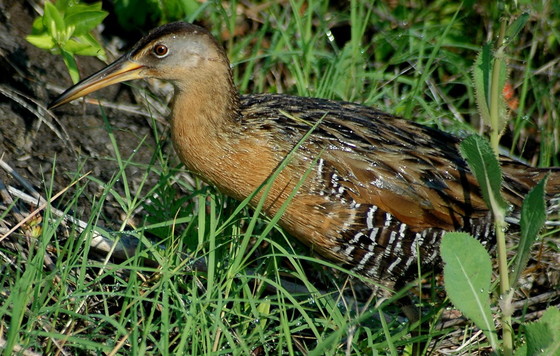 King rail is a State of the Birds "tipping" species that's also in Georgia's Wildlife Action Plan. (Todd Schneider/DNR)
A new review of the status of birds in the U.S. provides mostly bad news yet with a glint of hope.
According to the recently released State of the Birds 2022 report, compiled by more than 30 science and conservation organizations:
- Over half of the bird species in America are declining. Grassland birds lead the race to the bottom, their numbers declining by a third in the last 50 years.
- Populations of 70 bird species – dubbed “tipping species” – have shrunk by half or more in 50 years and could repeat that trend over the next 50 years.
- On the bright side, waterbird and duck numbers are growing, a sign that wetland conservation is paying off for them and other wildlife.
Of the report's 70 tipping species, Georgia's State Wildlife Action Plan considers 10 as high priorities for conservation here, from seaside sparrows to golden-winged warblers. Others listed migrate through or breed in Georgia.
Which raises the question: What can Georgians do?
HOW YOU CAN HELP
Here are three key ways:
- Support conservation done through the State Wildlife Action Plan by buying or renewing an eagle or monarch license plate, or annually renewing one of the older designs such as the hummingbird. Most of the $25 extra these tags cost goes to the Georgia Wildlife Conservation Fund.
-
Contribute to the fund directly, online or through Georgia's wildlife state income tax checkoff.
- Learn about federal legislation designed to stem declines in wildlife not fished for or hunted. Following the birds report, some conservation leaders pointed to Recovering America’s Wildlife Act, a bipartisan bill pending in the Senate and supported by 70 percent of Americans. Caroline Murphy, government relations manager for The Wildlife Society, urged Congress to pass “proactive funding measures, such as the Recovering America's Wildlife Act, that will ensure species have a fighting chance against extinction.”
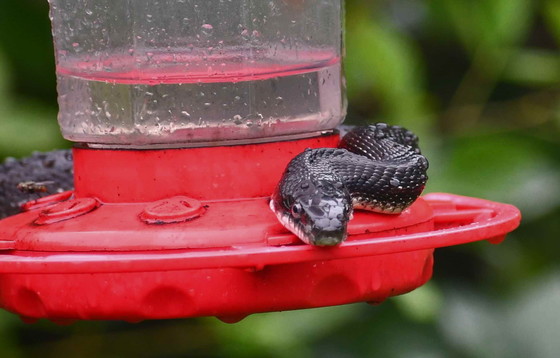 Rat snake on hummingbird feeder (Terry W. Johnson)
By TERRY W. JOHNSON
Predators catch and eat prey in our backyards every day.
Usually when we see this it takes the form of something like Fowler's toads catching small moths below our outside lights or spiders scampering to subdue flies ensnared in their webs. We don’t typically find these scenes upsetting.
However, when a Cooper’s hawk flashes across the yard and snatches a house finch at your feeder, some might find this true-life drama a little unsettling.
And for many, seeing a rat snake draped across a hummingbird feeder and holding a hummingbird in its mouth would be downright unnerving. Yet after watching hummers for decades, that’s what my wife and I recently saw for the first time. …
Read the rest of Terry’s column for insights into hummingbird predation.
Terry W. Johnson is a retired DNR manager and executive director of TERN, friends group of the Wildlife Conservation Section. Check out past columns and his blog. Permission is required to reprint a column.
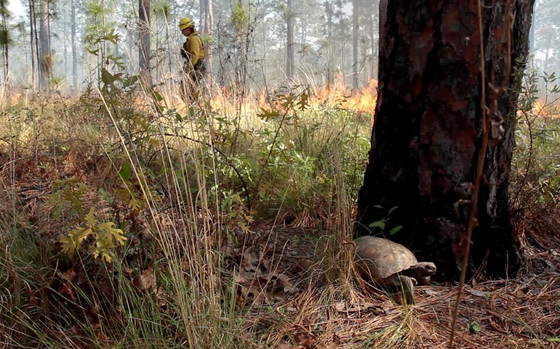 Tortoise Conservation Initiative efforts include prescribed fire to restore and maintain habitat. (Abel Klainbaum)
Gopher tortoises in the eastern part of their range, which includes Georgia, do not need to be listed under the federal Endangered Species Act, the U.S. Fish and Wildlife Service said last week. That decision is due in part to Georgia’s Gopher Tortoise Conservation Initiative, a collaboration of agencies, organizations, companies, foundations and landowners that has grown the number of protected viable gopher populations in the state from 36 to 62 so far, with a goal of 65.
Tricolored bats are, unfortunately, another story. Citing the impacts of white-nose syndrome, the Fish and Wildlife Service has proposed federally listing tricoloreds as endangered. These small bats have suffered estimated declines of more than 90 percent range-wide, with DNR winter cave surveys in north Georgia revealing a 93 percent drop, all largely attributed to the devastation caused by white-nose.
DNR is tangling with a non-native grass called sweet tanglehead on River Creek, the Rolf and Alexandra Kauka Wildlife Management Area near Thomasville. Invasive in at least the Southeast, sweet tanglehead grows 6-8 feet tall, can take over forest stands and fields, and bears seeds with barbs and sharp bristles that can burrow into the skin and even the nasal passages of animals.
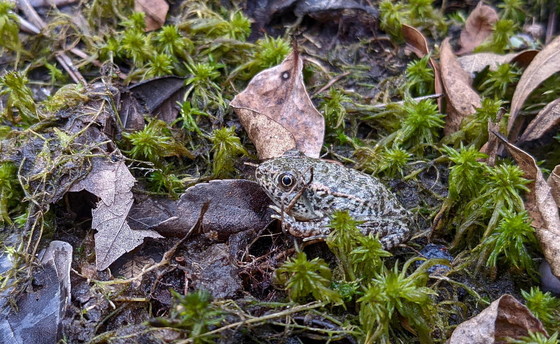 Juvenile gopher frog released at Alapaha River WMA (Vanessa Lane/ABAC)
Gopher frogs have a leg up at Alapaha River Wildlife Management Area, thanks to Abraham Baldwin Agricultural College and Gaskins Forest Education Center. Led by ABAC’s Dr. Vanessa Lane, the school and center teamed to raise and release 450 gopher frogs to boost the rare amphibian’s numbers at the south Georgia WMA.
Changes aimed at further protecting endangered North Atlantic right whales – from new vessel speed regulations to Atlantic Large Whale Take Reduction Plan amendments targeting the risk of entanglement in fishing rope – are spurring debate. Meanwhile, the right whale “Snow Cone” spotted entangled but with a calf off Georgia’s coast this winter was seen last month in the Northeast with a new entanglement, no calf and no hope, say experts, of survival.
A team fish sampling effort by DNR’s Freshwater Biodiversity Program staff yielded cool finds in the eastern part of the Coosa River Basin. The catch – and release – included a federally endangered Etowah darter in an Amicalola Creek tributary (the first found there since 2008), state-listed holiday darters and other endemic species such as Etowah bridled darter and Etowah and mountain crayfish.
Quick hits:
 DNR staff with Dekalb Commissioner Larry Johnson, second from left, at a Gateway to Fishing event (DNR)
Names in the news: DNR wildlife biologist Thomas Floyd helped Ranger Nick (aka UGA Extension's Nick Fuhrman) get a grip on snot otters for this Farm Monitor video. Linda May, outreach coordinator for DNR's Wildlife Conservation Section, added wildlife viewing ops – including with a box turtle and eastern kingsnake – to a DNR Gateway to Fishing event that drew about 60 people to a Decatur park. DNR Game Management Assistant Chief Dr. Tina Johannsen has received the Distinguished Alumnus Award from the UGA Warnell School of Forestry and Natural Resources, Warnell's highest honor for a graduate. DNR fire safety officer Shan Cammack helped pull off the annual Georgia Prescribed Fire Council meeting in Tifton, which added a last-minute Facebook live feed and webinar because of Hurricane Ian but still had an in-person crowd of some 270. Georgia Conservancy named Courtney Reich its new coastal director. Charles McMillan, who was in that role, is now the nonprofit's natural resources director.
WHAT YOU MISSED ...
In the previous Georgia Wild:
- Joro Watch is on
- Comeback kestrels
- Monitoring manatees
- Yard aid for fall migrants
 "Rafinesque's Big-eared Bat Takes Flight," DNR
DNR's Berkeley Boone talks salamanders, DNR
(audio) Sapelo NERRds podcast, Sapelo Island National Estuarine Research Reserve
Timber rattlesnakes fighting on Lanahassee Creek WMA, DNR
"Habitat Restoration in Georgia (Pittman Robertson funding)," Blood Origins
"Ranger Nick: Joro Spiders," Farm Monitor
Giant swallowtail caterpillar looks like bird poop, DNR
(audio) "Going wild with Dr. Rae Wynn-Grant," PBS podcast (series site)
Urban Wildlife Program staff free buck tangled in hammock, DNR
"Don't Go chasing Water Bugs," Deep Look
"Georgia partnerships play role in tortoise listing decision," Savannah Business Journal. Also: "'Iconic' tortoises don't need endangered species protection," WABE-FM (98.1, Atlanta); "Georgia gopher tortoises skirt endangered status," Savannah Morning News.
"NOAA identifies 36 additional injured, ill right whales," Maine Public. Also on Maine Public: "Study: fewer breeding female right whales than thought."
"New satellite imagery first to ID right whale from space," American Association for the Advancement of Science (study: Marine Mammal Science)
"Exotic reptiles escaping across state has officials worried," The State (Columbia, S.C.)
"Catch fall migration along Georgia's Colonial Coastal Birding Trail," Yahoo! News (via Marietta Daily Journal). Also: GPB.
"Students celebrate birds in DNR art competition," The Albany Herald and others.
"NALT helps transfer two conservation easement areas to DNR," EIN Presswire
(+audio) "Fish tell a creek's story; to catch them is shocking," GPB
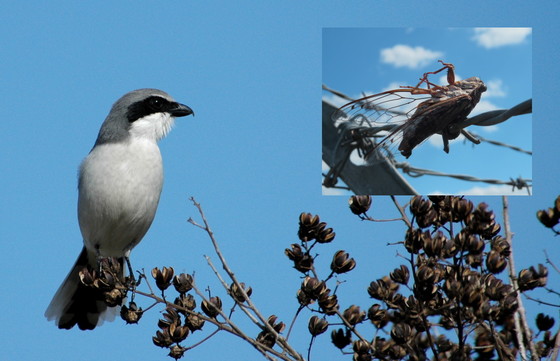 Loggerhead shrike; (inset) cicada cached on barbed wire (Todd Schneider/DNR, Dirk J. Stevenson)
This profile isn’t for the squeamish. With that caution in mind, join us for a close look at loggerhead shrikes, songbirds known both for their bold appearance and seemingly bizarre tendency to impale their prey.
Top
|